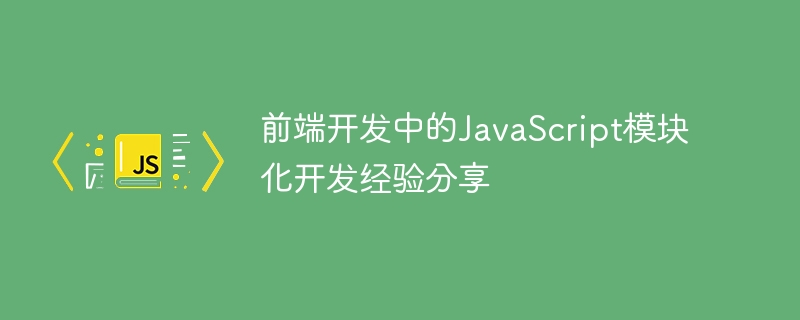

Sharing JavaScript modular development experience in front-end development
With the rapid development of Web technology, front-end development has become an important field on par with back-end development. In front-end development, JavaScript is a very critical language. It can not only provide interactivity and animation effects for web pages, but also implement complex business logic. However, as the project expanded and became more complex, we could no longer continue to write all the code in one file. This not only made the code difficult to maintain, but also led to naming conflicts and code duplication.
In order to solve this problem, modular development came into being. Modular development of JavaScript allows us to split the code into independent modules, each module is responsible for completing a specific function. In this way, we can better organize and manage the code and improve the reusability and maintainability of the code. Below is some experience sharing about JavaScript modular development that I have accumulated in front-end development.
First of all, it is very important to choose the appropriate modular development tool or framework. There are many popular modular development tools in the JavaScript community, such as CommonJS, AMD, ES6 Modules, etc. We should choose appropriate tools based on the needs of the project and the actual situation to avoid frequent switching and relearning. At the same time, we can also use some ready-made modular frameworks, such as RequireJS, Webpack, Rollup, etc., which provide more functions and convenience in modular development.
Secondly, correctly organizing and managing code is the core of modular development. In a project, we can divide the code into multiple modules based on functions or business scenarios. Each module should have a clear single responsibility and follow the principle of high cohesion and low coupling. Not only that, there should be good dependencies between modules to avoid circular dependencies and over-dependence. In order to improve the readability and maintainability of the code, we can use appropriate comments and documentation to clarify the relationships and functions between modules.
In addition, communication and data transfer between modules are also issues that need attention in modular development. In modular development of JavaScript, we can share data between modules by exporting and importing modules. In CommonJS and ES6 Modules, we can export and import modules using the export and import keywords. In AMD, we can use the define and require functions to achieve this. At the same time, you can also use event subscription and publishing mechanisms to decouple communication between modules, such as using EventEmitter or implementing a simple publish-subscribe model yourself.
In addition, we can also use build tools to optimize modular development. Nowadays, widely used build tools in front-end development include Grunt, Gulp, Webpack, etc. These tools can help us automate the build process, including code merging, compression, packaging, etc. By properly configuring the build tools, we can merge multiple modules into a single file, reduce network requests and increase page loading speed.
Finally, continuous learning and research are essential in modular development. The JavaScript ecosystem is very active, with new tools and frameworks emerging every day. We should keep paying attention to and learning new technologies and understand the latest modular development ideas and practices. At the same time, we can also participate in open source projects, read source code, communicate and share experiences with other developers.
In short, the modular development of JavaScript brings greater flexibility and maintainability to front-end development. By choosing appropriate tools and frameworks, correctly organizing and managing code, optimizing communication and data transfer, combining construction tools, and continuous learning and research, we can better conduct modular development and improve development efficiency and code quality. I hope these experience sharing will be helpful to front-end developers.
The above is the detailed content of JavaScript modular development experience sharing in front-end development. For more information, please follow other related articles on the PHP Chinese website!




